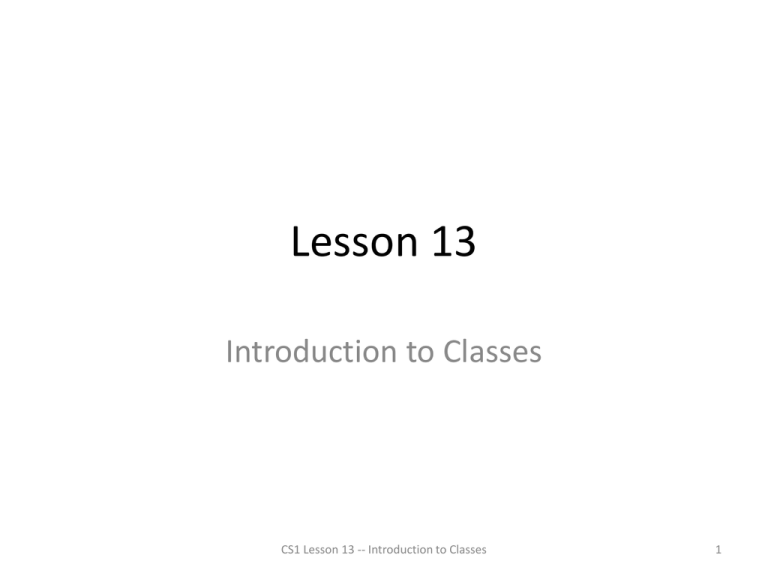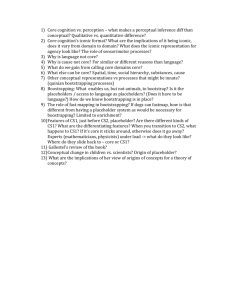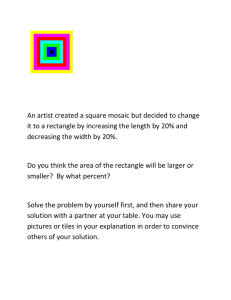Lesson 13 Introduction to Classes CS1 Lesson 13 -- Introduction to Classes 1
advertisement

Lesson 13
Introduction to Classes
CS1 Lesson 13 -- Introduction to Classes
1
Procedural versus Object-Oriented
Programming
• Procedural programming focuses on the
process/actions that occur in a program. The
program starts at the beginning, does
something, and ends.
• Object-Oriented programming is based on the
data and the functions that operate on it.
Objects are instances of abstract data types
that represent the data and its functions
CS1 Lesson 13 -- Introduction to Classes
2
Key Point
• An object or class contains the data and the
functions that operate on that data. Objects
are similar to structs but contain functions, as
well.
CS1 Lesson 13 -- Introduction to Classes
3
Limitations of Procedural
Programming
• If the data structures change, many
functions must also be changed
• Programs that are based on complex
function hierarchies are:
– difficult to understand and maintain
– difficult to modify and extend
– easy to break
CS1 Lesson 13 -- Introduction to Classes
4
Object-Oriented Programming
Terminology
• class: like a struct (allows bundling of
related variables), but variables and functions
in the class can have different properties than
in a struct
• object: an instance of a class, in the same
way that a variable can be an instance of a
struct
CS1 Lesson 13 -- Introduction to Classes
5
Classes and Objects
• A Class is like a blueprint and objects are like
houses built from the blueprint
CS1 Lesson 13 -- Introduction to Classes
6
Object-Oriented Programming
Terminology
• attributes: members of a class
• methods or behaviors: member functions of a
class
CS1 Lesson 13 -- Introduction to Classes
7
More Object Terms
• data hiding: restricting access to certain
members of an object
• public interface: members of an object that
are available outside of the object. This allows
the object to provide access to some data and
functions without sharing its internal details
and design, and provides some protection
from data corruption
CS1 Lesson 13 -- Introduction to Classes
8
Creating a Class
• Objects are created from a class
• Format:
class ClassName
{
declaration;
declaration;
};
CS1 Lesson 13 -- Introduction to Classes
9
Classic Class Example
CS1 Lesson 13 -- Introduction to Classes
10
Access Specifiers
• Used to control access to members of the
class
• public: can be accessed by functions
outside of the class
• private: can only be called by or accessed
by functions that are members of the class
• In the example on the next slide, note that the
functions are prototypes only (so far)
CS1 Lesson 13 -- Introduction to Classes
11
Class Example
CS1 Lesson 13 -- Introduction to Classes
12
Access Specifiers
Private Members
Public Members
CS1 Lesson 13 -- Introduction to Classes
13
Access Specifiers (continued)
• Can be listed in any order in a class
• Can appear multiple times in a class
• If not specified, the default is private
CS1 Lesson 13 -- Introduction to Classes
14
Using const With Member Functions
• const appearing after the parentheses in a
member function declaration specifies that
the function will not change any data in the
calling object.
CS1 Lesson 13 -- Introduction to Classes
15
Defining a Member Function
• When defining a member function:
– Put prototype in class declaration
– Define function using class name and scope
resolution operator (::)
int Rectangle::setWidth(double w)
{
width = w;
}
CS1 Lesson 13 -- Introduction to Classes
16
Global Functions
• Functions that are not part of a class, that is,
do not have the Class::name notation,
are global. This is what we have done up to
this point.
CS1 Lesson 13 -- Introduction to Classes
17
Accessors and Mutators
• Mutator: a member function that stores a
value in a private member variable, or
changes its value in some way
• Accessor: function that retrieves a value from
a private member variable. Accessors do not
change an object's data, so they should be
marked const.
CS1 Lesson 13 -- Introduction to Classes
18
Defining an Instance of a Class
• An object is an instance of a class
• Defined like structure variables:
Rectangle r;
• Access members using dot operator:
r.setWidth(5.2);
cout << r.getWidth();
• Compiler error if you attempt to access a
private member using dot operator
CS1 Lesson 13 -- Introduction to Classes
19
Derived Attributes
• Some data must be stored as an attribute.
• Other data should be computed. If we stored
“area” as a field, its value would have to
change whenever we changed length or
width.
• In a class about a “person,” store birth date
and compute age
CS1 Lesson 13 -- Introduction to Classes
20
Pointers to Objects
• Can define a pointer to an object:
Rectangle *rPtr;
• Can access public members via pointer:
rPtr = &otherRectangle;
rPtr->setLength(12.5);
cout << rPtr->getLength() << endl;
CS1 Lesson 13 -- Introduction to Classes
21
Dynamically Allocating Objects
Rectangle *r1;
r1 = new Rectangle();
• This allocates a rectangle and returns a
pointer to it. Then:
r1->setWidth(12.4);
CS1 Lesson 13 -- Introduction to Classes
22
Private Members
• Making data members private provides
data protection
• Data can be accessed only through public
functions
• Public functions define the class’s public
interface
CS1 Lesson 13 -- Introduction to Classes
23
Private Members
Code outside the class must use the class's
public member functions to interact with the
object.
CS1 Lesson 13 -- Introduction to Classes
24
Separating Specification from
Implementation
• Place class declaration in a header file that serves
as the class specification file. Name the file
ClassName.h, for example, Rectangle.h
• Place member function definitions in
ClassName.cpp, for example,
Rectangle.cpp File should #include the
class specification file
• Programs that use the class must #include the
class specification file, and be compiled and
linked with the member function definitions
CS1 Lesson 13 -- Introduction to Classes
25
Inline Member Functions
• Member functions can be defined
– inline: in class declaration
– after the class declaration
• Inline appropriate for short function bodies:
int getWidth() const
{ return width; }
CS1 Lesson 13 -- Introduction to Classes
26
Tradeoffs – Inline vs. Regular Member
Functions
• Regular functions – when called, compiler
stores return address of call, allocates
memory for local variables, etc.
• Code for an inline function is copied into
program in place of call – larger executable
program, but no function call overhead, hence
faster execution
CS1 Lesson 13 -- Introduction to Classes
27
Constructors
• Member function that is automatically called
when an object is created
• Purpose is to construct an object and do
initialization if necessary
• Constructor function name is class name
• Has no return type specified
• (What is the real return type?)
CS1 Lesson 13 -- Introduction to Classes
28
Default Constructors
• A default constructor is a constructor that takes no
arguments.
• If you write a class with no constructor at all, C++ will
write a default constructor for you, one that does
nothing.
• A simple instantiation of a class (with no arguments)
calls the default constructor:
Rectangle r;
CS1 Lesson 13 -- Introduction to Classes
29
Passing Arguments to Constructors
• To create a constructor that takes arguments:
– indicate parameters in prototype:
Rectangle(double, double);
– Use parameters in the definition:
Rectangle::Rectangle(double w, double
len)
{
width = w;
length = len;
}
CS1 Lesson 13 -- Introduction to Classes
30
Passing Arguments to Constructors
• You can pass arguments to the constructor when you
create an object:
Rectangle r(10, 5);
CS1 Lesson 13 -- Introduction to Classes
31
More About Default Constructors
• If all of a constructor's parameters have default
arguments, then it is a default constructor. For
example:
Rectangle(double = 0, double = 0);
• Creating an object and passing no arguments
will cause this constructor to execute:
Rectangle r;
CS1 Lesson 13 -- Introduction to Classes
32
Classes with No Default Constructor
• When all of a class's constructors require
arguments, then the class has NO default
constructor
• When this is the case, you must pass the
required arguments to the constructor when
creating an object
CS1 Lesson 13 -- Introduction to Classes
33
Destructors
• Member function automatically called when
an object is destroyed
• Destructor name is ~classname, e.g.,
~Rectangle
• Has no return type; takes no arguments
• Only one destructor per class, i.e., it cannot be
overloaded
• If constructor allocates dynamic memory,
destructor should release it
CS1 Lesson 13 -- Introduction to Classes
34
Constructors, Destructors, and
Dynamically Allocated Objects
• When an object is dynamically allocated with
the new operator, its constructor executes:
Rectangle *r = new Rectangle(10,
20);
• When the object is destroyed, its destructor
executes:
delete r;
CS1 Lesson 13 -- Introduction to Classes
35
Overloading Constructors
• A class can have more than one constructor
Overloaded constructors in a class must have
different parameter lists:
Rectangle();
Rectangle(double);
Rectangle(double, double);
CS1 Lesson 13 -- Introduction to Classes
36
Only One Default Constructor
and One Destructor
• Do not provide more than one default constructor
for a class: one that takes no arguments and one that
has default arguments for all parameters
Square();
Square(int = 0);
// will not compile
• Since a destructor takes no arguments, there can
only be one destructor for a class
CS1 Lesson 13 -- Introduction to Classes
37
Member Function Overloading
• Non-constructor member functions can
also be overloaded:
void setCost(double);
void setCost(char *);
• Must have unique parameter lists as for
constructors
CS1 Lesson 13 -- Introduction to Classes
38
Using Private Member Functions
• A private member function can only be
called by another member function
• It is used for internal processing by the class,
not for use outside of the class
• If you wrote a class that had a public sort
function and needed a function to swap two
elements, you’d make that private
CS1 Lesson 13 -- Introduction to Classes
39
Arrays of Objects
• Objects can be the elements of an array:
Rectangle rooms[8];
• Default constructor for object is used when
array is defined
CS1 Lesson 13 -- Introduction to Classes
40
Arrays of Objects
Must use initializer list to invoke constructor that
takes arguments:
Rectangle rArray[3]={Rectangle(2.1,3.2),
Rectangle(4.1, 9.9),
Rectangle(11.2, 31.4)};
CS1 Lesson 13 -- Introduction to Classes
41
Arrays of Objects
• It isn't necessary to call the same constructor
for each object in an array:
Rectangle
rArray[3]={Rectangle(2.1,3.2),
Rectangle(),
Rectangle(11.2, 31.4)};
CS1 Lesson 13 -- Introduction to Classes
42
Accessing Objects in an Array
• Objects in an array are referenced using subscripts
• Member functions are referenced using dot notation:
rArray[1].setWidth(11.3);
cout << rArray[1].getArea();
CS1 Lesson 13 -- Introduction to Classes
43
The Unified Modeling Language
• UML stands for Unified Modeling Language.
• The UML provides a set of standard diagrams
for graphically depicting object-oriented
systems
CS1 Lesson 13 -- Introduction to Classes
44
UML Class Diagram
• A UML diagram for a class has three main
sections.
CS1 Lesson 13 -- Introduction to Classes
45
Example: A Rectangle Class
class Rectangle
{
private:
double width;
double length;
public:
bool setWidth(double);
bool setLength(double);
double getWidth() const;
double getLength() const;
double getArea() const;
};
CS1 Lesson 13 -- Introduction to Classes
46
UML Access Specification Notation
• In UML you indicate a private member with
a minus (-) and a public member with a
plus(+).
These member variables are
private.
These member functions are
public.
CS1 Lesson 13 -- Introduction to Classes
47
UML Data Type Notation
• To indicate the data type of a member variable,
place a colon followed by the name of the data
type after the name of the variable.
- width : double
- length : double
CS1 Lesson 13 -- Introduction to Classes
48
UML Parameter Type Notation
• To indicate the data type of a function’s
parameter variable, place a colon followed by
the name of the data type after the name of
the variable.
+setWidth(w : double)
CS1 Lesson 13 -- Introduction to Classes
49
UML Function Return Type Notation
• To indicate the data type of a function’s return
value, place a colon followed by the name of
the data type after the function’s parameter
list.
+ setWidth(w : double) : void
CS1 Lesson 13 -- Introduction to Classes
50
The Rectangle Class
CS1 Lesson 13 -- Introduction to Classes
51
Showing Constructors and Destructors
No return type listed for
constructors or destructors
Constructors
Destructor
CS1 Lesson 13 -- Introduction to Classes
52






